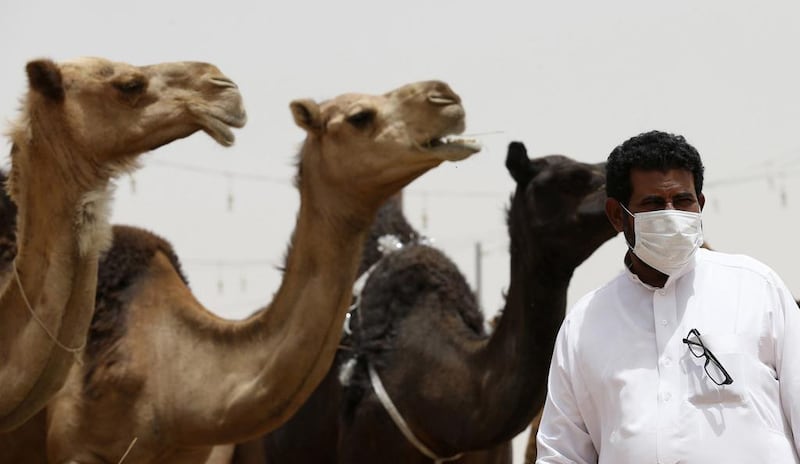Up until just a couple of months ago, there were just 15 or so cases a month. But then, in April alone, there were more than 200. This month scores more have been reported. The recent spread of Middle East Respiratory Syndrome (Mers) has been nothing if not dramatic.
Last month’s 217 diagnosed cases were more than for all previous months since the illness was identified in 2012 put together. A string of countries, including the US, Greece and Philippines, recorded their first cases last month, while cases this month in the Netherlands and Lebanon brought the number of nations affected to 18.
In Saudi Arabia, the worst-affected country, there have been more than 500 cases, while globally the number tops 600. The UAE, the second most severely hit country, has had more than three dozen cases, mostly affecting healthcare workers, with nine additional cases in Abu Dhabi reported to the World Health Organisation this month.
And the disease is deadly. It typically starts with flu-like symptoms before progressing to breathing difficulties and pneumonia. It kills one in three of those affected.
So far, the virus – a so-called coronavirus similar to the one that causes Severe Acute Respiratory Syndrome (Sars), which killed hundreds of people in Asia in the early 2000s – has not been spreading particularly quickly.
But the fear is that the recent upswing in cases could indicate that something has changed to make it more easily transmissable. That, combined with its current high kill rate, could make a nightmarish combination.
“We’ve seen a really sharp turn in the trajectory … [and] we’re seeing much more spillover to other parts of the world,” said Dr Kamran Khan, an associate professor at the University of Toronto and a specialist in infectious diseases at St Michael’s Hospital in Toronto. Last year he published a study on the international spread of Mers, and describes the recent rise as “very concerning on a number of fronts”.
It appears though, that the feared tipping point, when the virus mutates to become more easily passed from person to person, has not yet been reached.
A recent University of Bonn study compared the RNA (ribonucleic acid, the virus equivalent of DNA) from the viruses in 30 recent Saudi cases to the genetic sequences from earlier cases. It found the virus was not, thus far, evolving genetically. So the current surge in cases can’t be attributed to a new mutation that helps the virus spread more easily.
So what is behind the upsurge? It could be the weather, or an increase in the circulation of the virus at this time of year because more camels are being born. Some of the problem could be poor hygiene control in Saudi hospitals. Part of the explanation could simply be that now the authorities are actively looking for the disease, they’re finding more of it.
Finding a definitive reason is difficult without a better understanding of where infections are coming from.
We know that people have caught the virus directly from camels, with the nasal discharges of infected animals capable of transmitting the Mers virus. However, it is unclear what proportion of infections camel-to-person transmissions account for.
“The ideal would be to address the risks at their source but … there’s a lot we don’t know about how the virus is getting into human populations. Is it directly from camels? It’s very difficult to say because there are a lot of unknowns,” said Dr Khan.
Research published last year found several cases of the virus jumping from animals to people, as well as from people to other people.
One of that study’s authors, Prof Alimuddin Zumla, director of the Centre for Infectious Diseases and International Health at University College London, believes camel-to-human transmission is key. He said, however, that other experts have said “anything is possible”.
The ultimate reservoir of the disease – the virus's favoured host – is believed to be bats. Rats have also been implicated in its spread.
It is thought to have been present in camels for many years, although typically these animals, which can be identified as carriers by the presence of antibodies to the virus in their blood, do not suffer serious illness. For camels, Mers is largely a matter of a runny nose, with only a few other minor symptoms.
And for a disease whose homeland is Saudi Arabia, there is an ever-present concern: the huge number of pilgrims making the trip to Mecca each year from every corner of the world. That number will surge next month, as many perform Umrah during Ramadan, and again in October when millions perform Haj.
There were fears last year that Haj would lead to widespread outbreaks of Mers, which did not come to pass – but still Dr Khan is concerned that this year’s pilgrimages “could amplify the international spread of the disease”.
“Saudi pilgrims represent a large proportion of the pilgrims. The mixing of these populations could lead to local spread and dispersion to different countries,” he said.
Such are the concerns generated by Mers that some groups of pilgrims have cancelled their trips to perform Umrah, while others have decided not to book in the first place.
“It’s difficult to say where the trajectory is going, but there are a lot of concerns around the globe this could become a much larger event in the months ahead,” said Dr Khan.
But not all are so concerned. It is still possible, some say, that Mers will remain a largely regional concern.
Prof John Oxford, a professor of virology at Queen Mary College London, compares viruses with dogs, and suggested Mers was not the type that would be most feared, at least in terms of its geographical spread.
“It’s not a greyhound virus or a highly aggressive virus like a bulldog,” he said. “It’s like a dachshund. A little dachshund with short legs is not going to get anywhere.”
Still, Mers looks set to remain a major concern in the Middle East.
To help prevent further outbreaks, healthcare workers at risk of contact with Mers patients are being advised to wear gloves and masks, measures that have recently helped to curtail the spread in hospitals in Saudi Arabia.
“The other recommendation is for people who own camels, they should be careful if the camel … is sick – if it’s got a runny nose,” said Prof Zumla. Saudi authorities advise that people wear gloves and masks when dealing with potentially sick animals. Officials have also said people should avoid eating uncooked camel meat and drinking unpasteurised camel milk.
But for how long will such measures be necessary? Prof Oxford believes it will be for good. It would, he said, be“very unwise” to return to a more relaxed approach as this could lead to more infections.
"It will be very difficult to extinguish it, but recognise there's a problem in the Middle East and you just have to take precautions," he said.
“Short of killing every bat, you’re not going to get rid of it. The wise thing is to increase the hygiene level. Washing hands is a good thing anyway [and] lessening contact with some of these animals and things we know are going to be the source.”
newsdesk@thenational.ae






